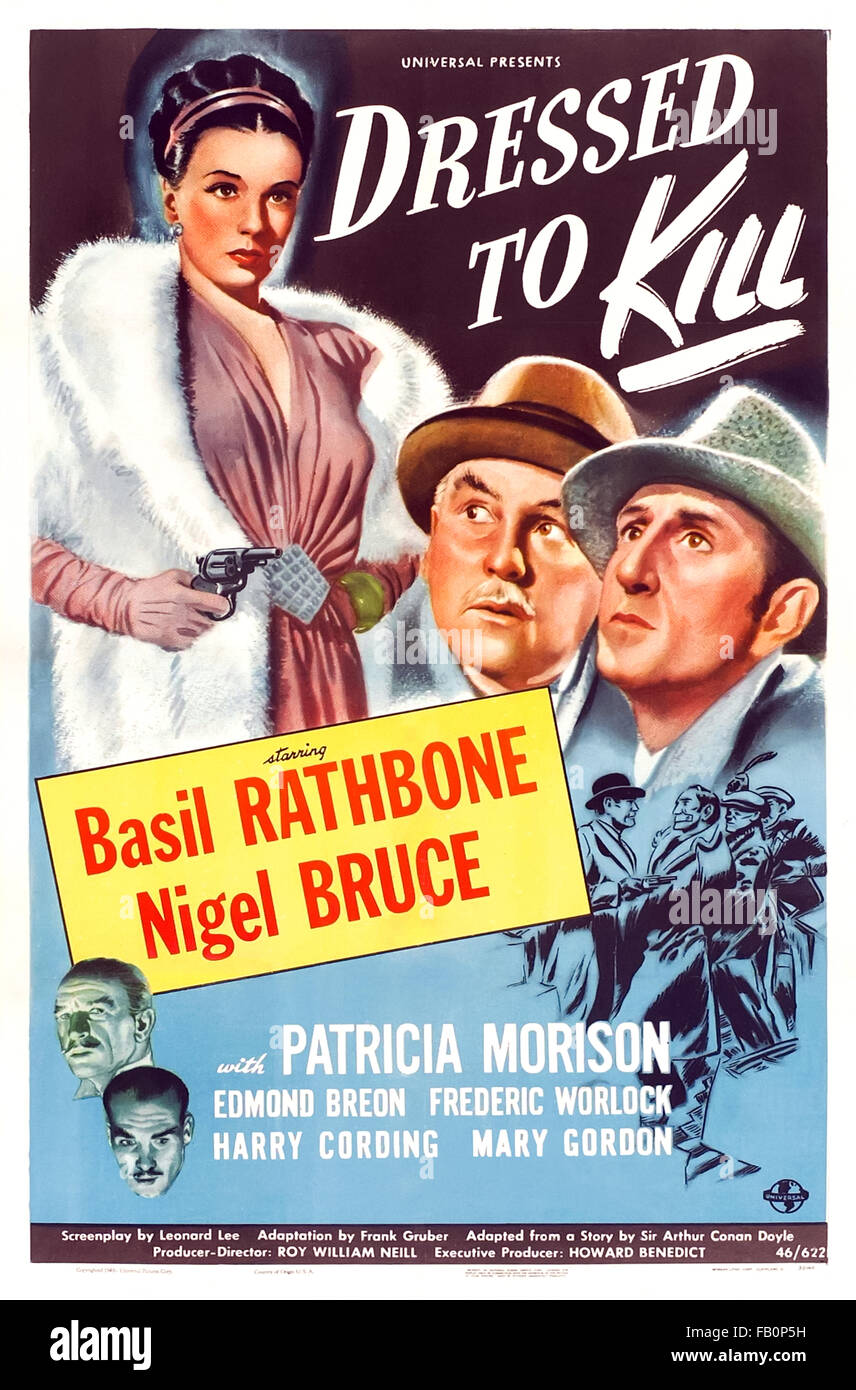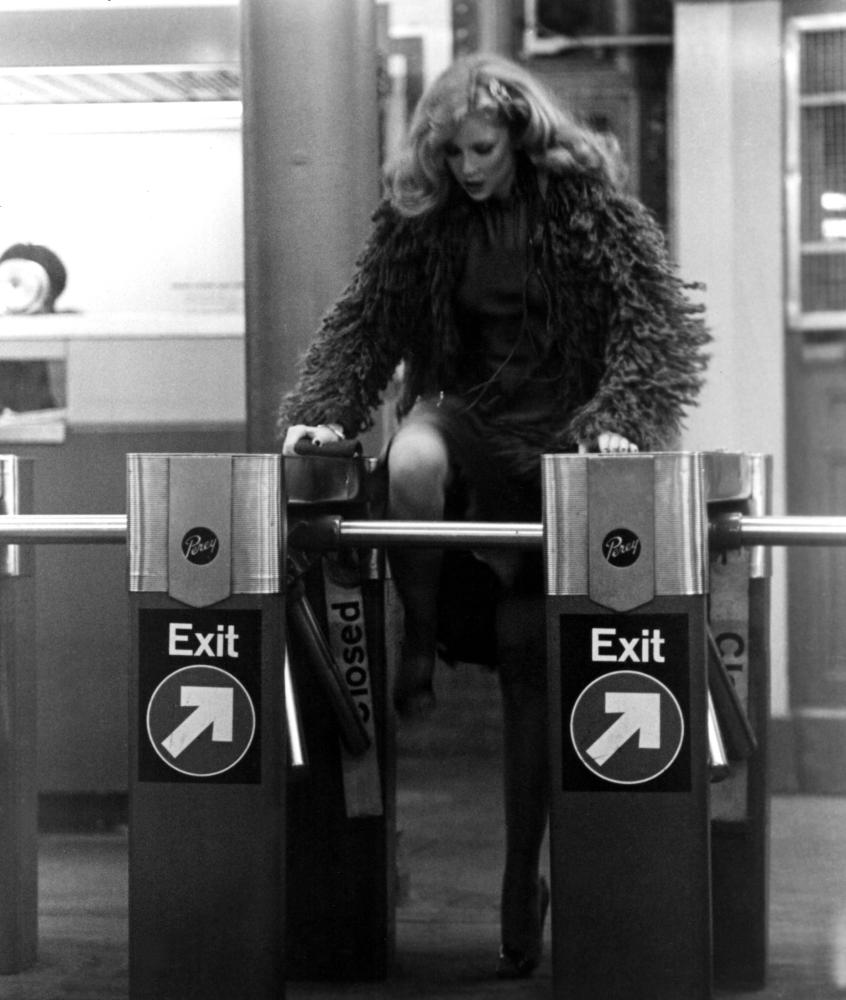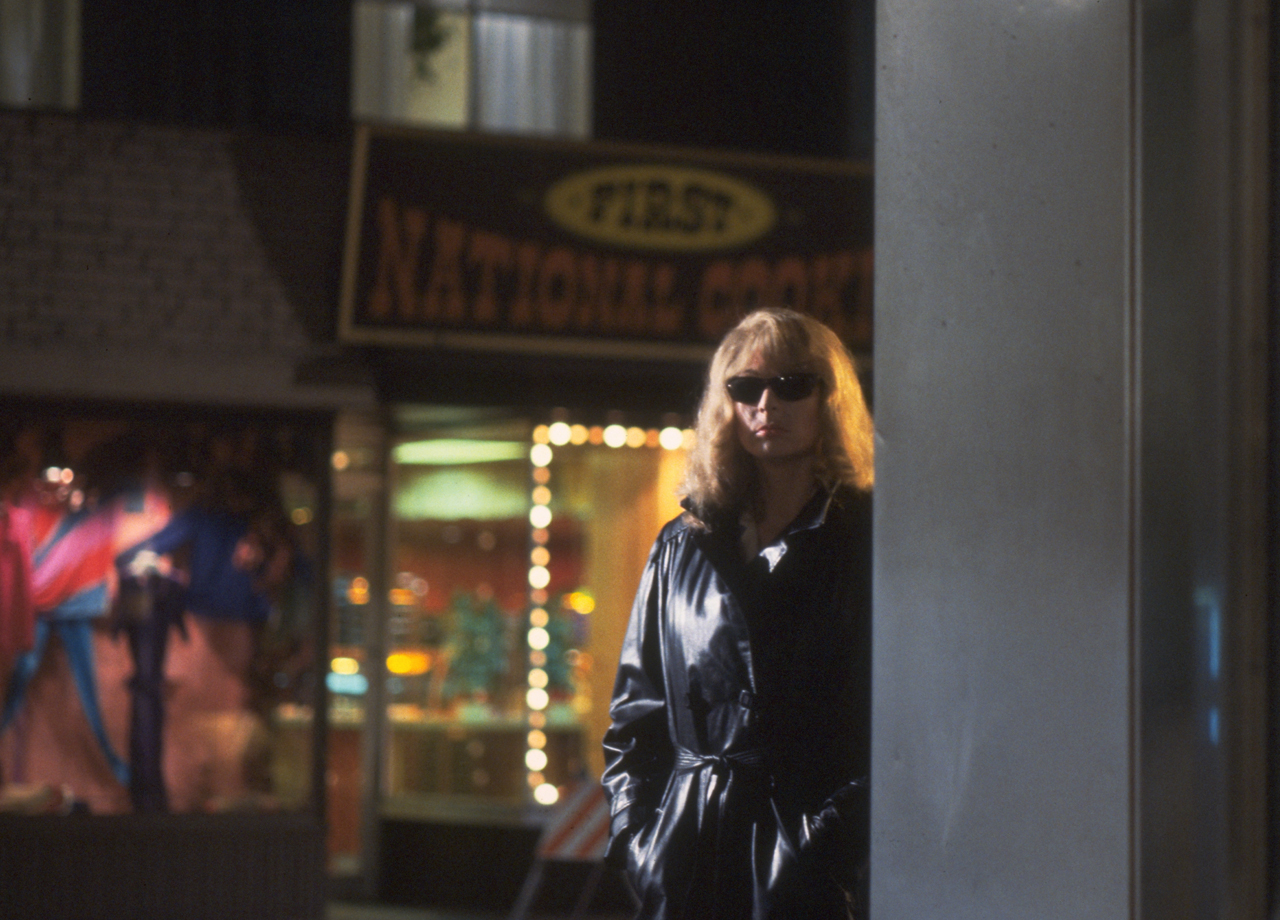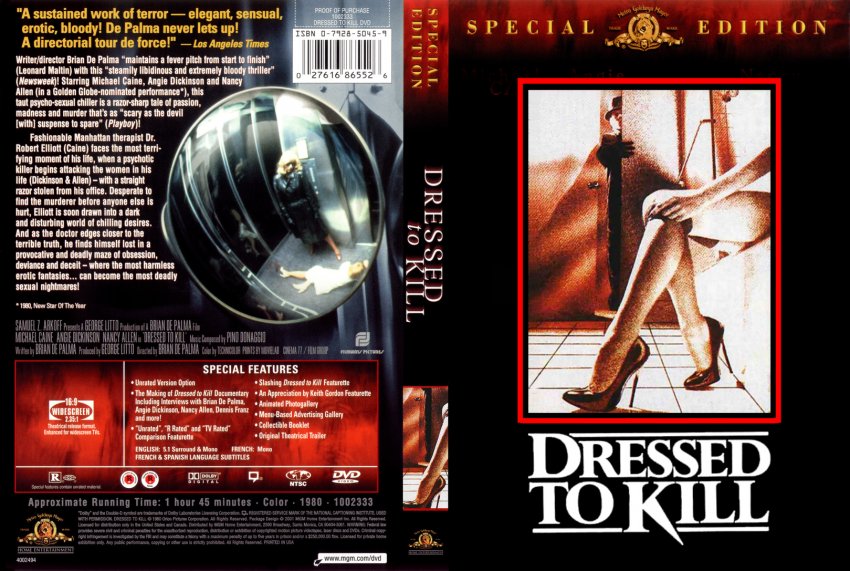In the 40 years since the stormy release of Brian De Palma's erotic thriller Dressed To Kill, the film has come to represent a kind of mainstream cinema that's no longer being made. No Hollywood film in 2020 would begin with an extended scene of a woman masturbating in the shower. Dressed To Kill forms a link between the giallo and erotic thriller. At the time of its release, feminist organizations picketed theaters showing the film, objecting to its fetishism of female sexuality and what they saw as its punishment of Angie Dickinson's character with graphic violence. At the time, they were much less vocal about its depiction of trans women as killers. Now, we live in an era where people cancel movies they object to on Twitter or write op-eds attacking them, rather than turning up in person to dissuade audiences from buying tickets; look at the moral panic over Joker last year.
But Dressed to Kill had vociferous defenders, with Pauline Kael and David Denby's rave reviews contributing to De Palma's reputation. And the film was a commercial hit, too, grossing $31.9 million on a budget less than a quarter of that. In fact, the latter is now far more central to current politics in the U.S. and the U.K.
Than it ever was when the film was released in 1980. The narrative is relatively straightforward, embellished with a couple of twists and a series of sympathetic, well-written characters. A middle-aged, sexually frustrated married woman has an affair, only to be razor-butchered minutes after by a mysterious, silent, classily dressed blonde.
Her murder is then investigated by a golden-hearted hooker, who is the only, though partial, witness to the horrific deed, and the teenage son of the deceased. For instance, not a lot of directors could pull off a scene like the famous elevator murder, which deposes the seemingly central character in the first half of the film, much like Hitchcock did in Psycho. Highly violent, yes, excessively brutal, sure, but filmed marvelously none the less, a sequence De Palma himself likes to call his most accomplished murder scene so far.
One of Brian De Palma's most divisive films, Dressed to Kill is a spine-chilling Alfred Hitchcock update for the late 1970s. Sexually frustrated wife and mother Kate Miller visits her New York psychiatrist, Dr. Elliott , to complain about her unfulfilling erotic life. When she then goes to meet her husband at a museum, she meets an anonymous man whom she follows out to a cab. After an afternoon of satisfying sex, Kate discovers that the man has a venereal disease, but that information becomes a moot point when a razor-wielding blonde woman slashes Kate to ribbons in the elevator of the man's building.
Blonde prostitute Liz , who caught a glimpse of the murderer, becomes both the prime suspect and the killer's next target. With the police less than willing to believe her story, Liz joins forces with Kate's son Peter to get the psychopath themselves. Well executed thriller with horror and drama elements, Dressed to Kill is an engaging film with a good cast of actors and well thought out characters. I felt that the film was expertly directed by Brian De Palma who always seems to make some standout, taught, riveting pictures. Dressed to Kill is a well made movie, one that boasts an impressive story, which grabs your attention from start to finish.
Fans of De Palma's work will surely enjoy this, and if you're looking for a tense, memorable thriller, Dressed to Kill is worth your time. While using a straight to the point approach to the way he tells history, De Palma manages to make a very good film, a film that succeeds at delivering thrills right from the moment it starts. As a thriller, Dressed to Kill is a fine example of one that gets it right, it steadily unfold before your eyes, an unravels its plot in a way that keeps you interested and add to that a great cast, and you have a film that is quite memorable in the long run. De Palma's work, I find is quite unique, and his style is mesmerizing and he has brought something quite worthwhile in the cinema. Dressed to Kill is among his best films, a well acted film that boasts some thrilling moments. The film is a genre classic, one that is a well crafted thriller and even with its weaker moments, still has enough good elements to make this a highly entertaining film.
It would be misguided and even slightly offensive, however, to discard Dressed to Kill–or any of the two other films mentioned, by that matter–as simple products of a craft individual's crazed fandom. De Palma uses a lot of narrative themes that his predecessor mastered, yes, but takes them onto the next level, infusing them with more than sufficient originality and individual, independent passion to call his work completely authorial. Dressed to Kill is like a spiced-up, power-up, less-restricted version of Psycho, and a work of art that even thirty six years upon its release still manages to entertain, frighten and intrigue many viewers.
Alfred Hitchcock's Psycho may be one of the most influential movies ever-for a start it was at least partially responsible for the whole subgenre of 'slasher' movies and the shower scene has inspired more homages than you can count. Brian De Palma's thriller Dressed To Kill is basically a semi remake of Psycho,right from the structure of it's story to it's villain right down to certain specific scenes. It's also an absolutely stunning piece of audience manipulation and perhaps more importantly a cracking thriller.
Watch this film knowing about the Psycho element and as long as you don't mind some graphic sex and violence you should have a whale of a time. In fact,to a modern audience it may very well be more effective than Psycho . Like William Friedkin's Cruising, in which a cop investigates murders taking place in the gay BDSM bar scene, or John Carpenter's apocalyptic sci-fi film The Thing, Dressed to Kill is an early '80s film whose bleak mood proved prophetic. Both Friedkin and Carpenter's films have been read as unintentional allegories about the damage done to gay men by AIDS and its spread around the time they were made. Dressed To Kill doesn't treat STDs as subtext; Kate discovers that the man she slept with has herpes. The film then punishes her for her promiscuity, as a woman in a blonde wig and sunglasses murders her with a razor as she leaves the building.
Sex worker Liz , who finds the body while trying to leave the building, then teams up with Kate's son Peter to search for her killer. But to paraphrase writer Delmore Schwartz, in nightmares begin responsibilities. De Palma does not depict men flatteringly in Dressed to Kill.
His camera may ogle Angie Dickinson (her shower scene was made more explicit with the help of a body double, who touches herself sexually in close-ups that stand out glaringly in the edit), but it also takes down male authority figures. Det. Marino is a sleazeball who could have stepped right out of De Palma's Scarface a few years later. In a misguided scene exuding casual racism, a group of African-American men menace Liz on a subway platform. Even the relatively benign Peter is a creepy nerd.
His habit of staring at women through binoculars may save someone's life in this case, but he still seems like an unflattering representative of the spectator. And he's not the only one – De Palma also likens us to the cab driver who adjusts his mirror to watch Kate having sex in his back seat, and a hospital full of mental patients who cheer on a murder. Dressed to Kill caused a lot of controversy at the time of its release. De Palma was accused of misogyny, objectifying women and treating the transgender issue in a hostile, paranoid way. And yet at the same time it's easy to see that the filmmaker approached his female characters more studiously and with more sympathy than their male counterparts.
He used violence and nudity and open eroticism to the maximum, but at the same time exaggerated so obviously and in such a way that one could say the images simultaneously pose a degree of criticism to the very sins many angered viewers accused him of. In any case, what De Palma did with Dressed to Kill was to create a modern erotic thriller that makes the audience sit at the edge of their seats, leaving them in a puzzled state, demanding a second viewing. Brian De Palma ascended to the highest ranks of American suspense filmmaking with this virtuoso, explicit erotic thriller. With its masterfully executed scenes of horror, voluptuous camera work, and passionate score, Dressed to Kill is a veritable symphony of terror, enhanced by vivid performances by Angie Dickinson, Michael Caine, and Nancy Allen. He also has Hitchcock's delight in bizarre and unexpected plot twists, and the chief delight of the first and best hour of "Dressed to Kill" comes from the series of surprises he springs on us.
Although other key characters are introduced, the central character in these early scenes is Kate Miller , an attractive forty-fiveish Manhattan woman who has a severe case of unsatiated lust. DePalma opens with a deliberately shocking shower scene , and then follows the woman as her sexual fantasies become unexpectedly real during a lunchtime trip to the museum. Dressed to Kill is a 1980 American erotic thriller film written and directed by Brian De Palma and starring Michael Caine, Angie Dickinson, Nancy Allen, and Keith Gordon.
It centers on the murder of a houseewife and an investigation involving a young prostitution who witnessed the murder, the victim's teenaged son, and her psychiatrist. The original music score is composed by Pino Donaggio. While taking a shower, Kate Miller, a middle-aged, sexually frustrated New York City housewife, has a rape fantasy while her husband stands at the sink shaving. Later that day, after complaining to her psychiatrist Dr. Robert Elliott about her husband's pathetic performance in bed, she meets a strange man at a museum and returns to his apartment where they continue an adulterous encounter that began in the taxicab. Before she leaves his apartment, she finds papers which certify that the man has a venereal disease. Panicked, Kate rushes into the elevator, but has to return to his apartment when she realizes she's forgotten her wedding ring.
When the elevator doors open, she's brutally slashed to death by a tall blonde woman wearing dark sunglasses. Liz Blake, a high-class call girl, is the only witness to the murder and she becomes the prime suspect and the murderer's next target. Liz is rescued from being killed by Kate's son Peter, who enlists the help of Liz to catch his mother's killer as Detective Marino, who's in charge of the case, is uncooperative in the investigation. Box office success arrives with a highly erotic thriller which, after Sisters, returns to the theme of doubles and to Hitchcock .
A beautiful and dissatisfied woman , an afternoon of clandestine sex, a savage murder, a young prostitute who witnesses the crime, an enigmatic psychiatrist, a gruff policeman, a blond, razor-wielding murderess. A perfect and terrifying movie, with textbook sequences , a highpoint of contemporary fear. The story is, that Kate Miller, unsatisfied with her sex life with her husband, and also apparently unsatisfied with herself in general, since she is seeing a psychiatrist. She finds herself venturing out into the world of infidelity, with some total stranger she runs into at an art museum. Ever the polite houseguest, after sex, while he is asleep, she searches for note paper with which to leave him a thank-you note, debating over how to compose it, etc.
And after she has written the note, she sees, in the drawer, a notice from the Public Health Department to the man she just slept with, notifying him that he has VD. So much for the afterglow, as she quickly exits his apartment. 104 minutesCountryUnited StatesLanguageEnglishBudget$6.5 millionBox office$31.9 millionDressed to Kill is a 1980 American erotic thriller film written and directed by Brian De Palma. Starring Michael Caine, Angie Dickinson, Nancy Allen, and Keith Gordon, the film depicts the events leading up to the murder of a New York City housewife before following a prostitute who witnesses the crime. It contains several direct references to Alfred Hitchcock's 1960 film Psycho, such as a man dressing as a woman to commit murders, significant shower scenes, and the murder of the female lead early in the picture.
De Palma and Kael both expressed their sexual appetites openly, which may be why the film critic responded so well to his films. Dressed to Kill represents the filmmaker's desires plainly, with the first half hour qualifying as languorous softcore porn. When that section culminates in a woman getting her face cut open with a razor, one can understand why a group called Women Against Violence and Pornography in Media would take to the streets to protest the movie. But De Palma was flirting with parody and satire while flaunting his complicity in everything the film criticizes. The vaseline-lensed cinematography and Pino Donaggio's swellingly romantic music in the opening scene remind us that we're watching a very subjective fantasy. The film is full of allusions to voyeurism, which rub our faces in the fact that it's a construct made to express male desire, with Peter based on a young De Palma.
Long accused of being a Hitchock ripoff artist, it'd be more accurate to say that the filmmaker brought the French New Wave's version of sampling and remixing into American cinema. One reason the film's ominous reputation persists is that it feels closer to an expressionistic Italian giallo than a traditional Hitchcockian thriller. As interest in the giallo has surged over the past decade, Dressed to Kill feels like its American cousin.
However, the film still does pick up on Hitchock's fascination with blonde women. The elevator murder presents a meeting of doppelgangers, as three women who look similar – the killer, Liz and Kate – come together in the same space. De Palma was willing to engage in camera movements purely for visual pleasure – the film presents a nightmarish world, where danger lurks in subway stations and psychiatrist's offices alike, but it depicts it with tremendous beauty. Even a horrifying scene in a mental hospital towards the film's end is shot with a moving camera that frames violence with breathtaking grace. By this point, De Palma was rarely making films anymore.
The last one was the fatally compromised but fascinating Domino, a thriller about the CIA and terrorism. Domino expressed dismay about their use as tools to promote violence, while subtly suggesting an anger towards the world of blockbusters and even Cannes-approved festival favorites – from which De Palma now feels shut out. Jake Paltrow and Noah Baumbach's 2015 documentary De Palma introduced the filmmaker to a generation of cinephiles who began watching movies after Kael retired from film criticism. It also had the unfortunate effect of turning De Palma into the cinematic version of a legacy act.
Carrie was a kick because it was my first film. Dressed to Kill I love for the reasons I told you. But Blow Out, I think, for so many reasons. No. 1, it was such a great piece at that time.
It really came together in terms of his style, content, all the actors, the performances… leading up to one of his best films ever, I think. What happened, of course, with Blow Out was I didn't like the character, it was never originally written for someone like myself or someone like John . It was really more of a small, dark, film noir piece, which I love, and the characters were a bit older than we were and really kind of past it.
It was over for them, very cynical and dark. The guy's character was very cerebral, more like a John Heard or Jimmy Woods, this type of person. It was a name that sounded so sweet, so seductive synonymous with Worth style power but their name was the coach. I don't consider myself to be a particularly ethical person, but I am fair.
Can keep a secret father son and house of Gucci. Two versions of the film exist in North America, an R-rated version and an unrated version. The unrated version is around 30 seconds longer and shows more pubic hair in the shower scene, more blood in the elevator scene (including a close-up shot of the killer slitting Kate's throat), and more explicit dialogue from Liz during the scene in Elliott's office.
These scenes were trimmed when the MPAA originally gave the film an X rating. But Dressed To Kill also tries to undermine male authority by having one of its representatives turn out to be a woman, which is much more troubling. In one of its biggest lifts from Psycho, the blonde woman wielding a razor turns out to be actually Liz's psychiatrist Dr. Elliott , transformed as Bobbi, his female alter-ego. Dressed to Kill engages in cheap irony by having Dr. Elliott watch a talk show interview with Nancy Hunt, a trans woman talking about her military background and heterosexuality, in a split screen with Liz in the right frame. While De Palma's use of the split diopter is one of his hallmarks, this framing emphasizes Liz as a "real" woman and suggests that Dr. Elliott and Nancy are aspiring to her identity. You can just feel it in the room, you know.
They really knew right away what they wanted, how they wanted it, just energetically. It's not uncommon to have directors work again and again with actors. The benefit of that is you really get to know, you kind of get to read each other. You know what the director is trying to say, and the director knows how to get the best out of the actor. I don't think being married had that much to do with it as much as that he knew how I operated and how to get the best out of me as an actress, as he did with other actors he'd work with again and again. I felt, I think at times, a little uncomfortable.
A little self-conscious in how other people might deal with me because I was the director's wife. It was never a problem for Brian and me, at least in my perspective. I don't know what he would say about it, but that is where it became a little bit, at times, awkward. A good movie that really only shows it's age when it gets to the subject of trans people.



























